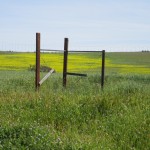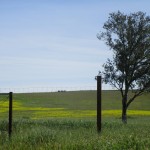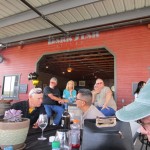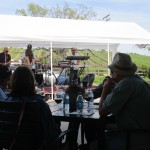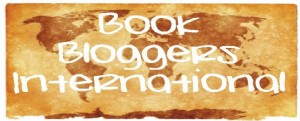California spring trip
Husband and I went down to the central coast of California for a few days to see the wildflowers, after all our rain and do some wine tasting (naturally). I’ll quickly share some photos (click to enlarge)
We took the back roads where spring has definitely sprung– yellow fields of wild mustard, western lilacs in bloom and even the live oak have green leaves. By June or July, all the green fields will turn brown in the brutal 100 degree heat of the central coast. So this is the time of year to go.
We went to one of our favorite wineries, Dark Star, to celebrate both the Paso Robles Zinfandel weekend and the owner’s birthday…there was even a very good band.
We slowly roamed the area, visiting different vineyards – one filled with lavender plantings and another with a view of Heart Hill. Everything was green, there were lambs frolicking in the fields, and we were ever so happy both from the beautiful weather and scenery and our afternoon wine tasting. Not a bad way to spend a couple of days in the central coastal region of Paso Robles and San Louis Obispo. This — we reminded ourselves — is why we live in California.
The Improbability of Love by Hannah Rothschild
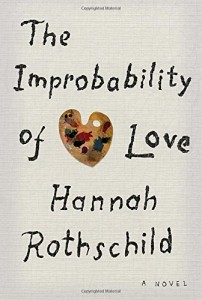 Ever since launching Book Barmy, I read with a pen and index card, making notes and jotting page numbers to reference for this blog. So I was surprised when halfway through this book I realized I hadn’t once picked up my pen. That’s a testament to this wonderful debut novel — I read for pure enjoyment, immediately lost in its pages.
Ever since launching Book Barmy, I read with a pen and index card, making notes and jotting page numbers to reference for this blog. So I was surprised when halfway through this book I realized I hadn’t once picked up my pen. That’s a testament to this wonderful debut novel — I read for pure enjoyment, immediately lost in its pages.
The Improbability of Love doesn’t fit neatly into a genre. It’s a drama, a love story, a history novel, a mystery and a satire. But mostly it is a book about art and the value of art both monetarily and emotionally.
Ms. Rothschild opens the book with a brilliant prologue which wryly captures behind the scenes at an art auction and then the cast of VIPs getting ready to bid on the art find of the century.
Then the novel goes back in time to Annie, a poor but accomplished chef who ducks into a secondhand store and buys a small, dusty painting which, unbeknownst to her, is an original Antoine Watteau, the French artist who revitalized the Baroque style of painting.
And so it begins…
Soon there is a large cast of colorful characters surrounding her little painting — unsavory art dealers, arrogant art experts, narcissistic art patrons, eccentric artists, wildly wealthy Russians in exile, and Barty a cross-dressing little man who makes his living instructing the newly rich on how to fit into society. Hitler’s art squad and a hidden identity also come into play, which adds more layers of mystery and intrigue.
In several chapters, the author tells the story from the perspective of the painting itself – this technique is fascinating in the beginning but gets bogged down later in the book as the painting tries to delineate its provenance from his starving artist through royalty, war, and finally modern day obscurity.
I especially enjoyed the author’s characterization of the rich art patrons and their decadent and spoiled worlds:
“Poor Aunty Jo”, Emeline said with feeling. “She never got over losing Topper.”
“I thought her husband was called Charles?”
“He was — Topper was her Pekinese.”
Annie secures a catering job for a Mrs. Appledore, one of the wealthy art patrons and with a “sky is the limit” budget recreates a dinner from art history. The description of the evening from decorating the dining room to the countless courses in this epic dinner is a wonder of descriptive food writing.
That said, Ms. Rothschild really shines with her knowledge of art history and her evocative descriptions of the art works, their history and the impact these paintings had on people’s lives. She opens our eyes to the dirty underbelly of fine art – thievery, cheating and outright greed brought most of today’s fine works of art to museums around the world. But the reader senses the author’s overriding sense of love – love of artists, the patrons, the business of art and especially the beauty of art.
The Improbability of Love is a totally entertaining read — an accomplishment of wicked humor, counterbalanced with war crimes — outrageous conspicuous consumption, mirrored against the reverence and importance of art in all its many forms.
Thanks to my friend Michael for loaning me his copy of this book.
Did You Ever Have a Family by Bill Clegg
At first, I rejected this book because in the opening chapters — the main character, June, looses her entire family in a horrific home accident, and with the cruelest twist of all – on the eve of her daughter’s wedding. I closed the book thinking, well this…
But then I read that Did You Ever Have a Family was nominated for both the Man Booker Prize and National Book Award and reviewers were using words such as “wondrous, eloquent and beautifully nuanced”. I decided to give it a another go. I vowed to give it four or five chapters this time.
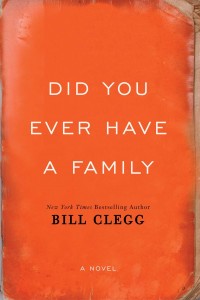 That did it, I was totally captured — caring so much about the characters that I couldn’t stop reading. Yet, I found myself reading slowly to fully absorb the language and the wisdom within its pages. But, be prepared, Did You Ever Have a Family is unusual — beyond just the missing question mark in the title — very little happens in the present and there is only a smattering of dialogue.
That did it, I was totally captured — caring so much about the characters that I couldn’t stop reading. Yet, I found myself reading slowly to fully absorb the language and the wisdom within its pages. But, be prepared, Did You Ever Have a Family is unusual — beyond just the missing question mark in the title — very little happens in the present and there is only a smattering of dialogue.
Mr. Clegg guides us through the devastation a tragedy brings to a small community and how the pain can spatter far and wide. With each chapter, he allows those effected to open their hearts.
Each character slowly reveals their memories and accounts. Everyone is linked, some in minor ways — others with strong connections. And it’s these connections that the author deftly weaves together into a bittersweet tapestry of people who love, who care and form more than just a community, but a family. This comes alive with some gorgeous writing – as here, with Lydia, a waitress in the diner :
When you see someone every day for a while, you settle into a rhythm and you come to count on them even if for nothing more than fifteen minutes each morning they spend sitting at your counter, on one of your stools, talking about the weather and giving you a big smile and thumbs up when they sink their teeth into a poppyseed muffin.
The quiet heartache of this novel will resonate with anyone who has lost a loved one. But surprisingly Mr. Clegg counteracts the sadness with the characters revealing little snippets of past and present happiness. Many of their happiest moments and memories are the little things — which often turn out to be enormous. I underlined this sentence and re-read it several times, simply lovely…
All we can do is play our parts and keep each other company. And it might be you never know the part you played.
Did You Ever Have a Family concludes 3,000 miles away from the original tragedy, with a gentle happiness warily gathering around the main characters. As if their new community – this new family — is a healing shawl around their shoulders .
I closed this book thinking how grateful I am for the communities that surround me — friends and family, of course, but also those people you may think don’t affect your life, but at the end of the day are all part of your story and your community.
Yes, Did You Ever Have a Family is sad, but it is also a heartening testament to the fundamental human need to connect with others. Those that keep us getting out of bed each morning, those we care for, worry about, love and if we’re lucky – wonders of wonders – they love us back.
A digital review copy was provided by Simon & Schuster via NetGalley.
Publicity in the Blogger-sphere
Breaking news … dit dit dit dit.
Book Barmy has its first bit of publicity with a featured post on Book Bloggers International.
In the coming months, I will be trying for more small features in the vast and impressive book blogger-sphere.
Watch this space. Thanks for reading Book Barmy
The Road to Little Dribbling by Bill Bryson
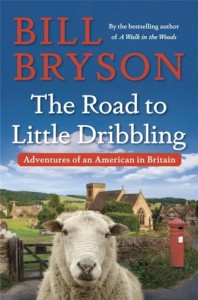 I’ve not posted here at Book Barmy for a bit, because I’ve been away. I’ve been to England, Scotland and Wales with one of my favorite pals, Bill Bryson.
I’ve not posted here at Book Barmy for a bit, because I’ve been away. I’ve been to England, Scotland and Wales with one of my favorite pals, Bill Bryson.
You know of my fondness for Mr. Bryson’s writing and I that have happily devoured almost all his books. The Road to Little Dribbling is his newest and it updates his 1995 classic Notes from a Small Island, in which he takes a farewell journey around the United Kingdom before moving back to the United States with his family.
Now it’s 20 years later and Mr. Bryson is once again touring the U.K. but this time as a citizen – which in his mind gives him license to grumble — and grumble he does.
But, sorry, I’m getting ahead of myself. This trip of remembrance doesn’t exactly retrace his 1996 journey. This trip is planned as the most direct route from one end of the country to the other – and Mr. Bryson being Mr. Bryson chooses Bognor Regis a quaint village at the the Southernmost tip as his starting point and for his finale in the Northern reaches of a stormy Scotland, a village aptly named Cape Wrath.
I had a great time traveling through the UK with Bill (seems silly to keep calling him Mr. Bryson after all our time together). He is full of witty observations and has a delightfully wry sense of humor even in the face of travel troubles or disappointments. When revisiting one of his favorite seaside hotels…
The hotel still strived for an air of elegance, but it was based much more on memory than merit.
Nevertheless, Bill finds mostly delight in his rambles through small villages, bus trips along suburban sprawl and driving a rental car along endless tangled back lanes. I knew we were meant for each other when he thinks nothing of a four mile walk for a cup of tea in a picturesque Cornwall village:
It was all very fine, in the cafe I had a refreshing cup of tea and a lovely dry piece of cake – cautiously flavorful in the British style, satisfying, but not so delicious that you would want a second piece for a month or so.
We also share a fondness for those obscure, out of the way sites not on the itinerary of tour groups or travel guides. He visits Leighton House in London:
In terms of decor it feels a little like a cross between a pasha’s den and a New Orleans bordello. It is full of Arabic tiles, silk wallpapers, colorful ceramics, and lots of art, much of it involving bare-breasted young women, which I am always up for.
Nonetheless, a few major tourist sites, such as Stonehenge and the Natural History Museum are re-visited with Bill’s insightful and varying opinions on their changes in the past 20 years.
As always, when traveling with Bill there is much to learn. We visit Slapton Sands, an unknown and secret D-day rehearsal site – where Allied troops could practice coming ashore. Tragically, the Allied side neglected to line up protection for the exercise and nine German torpedo boats attacked and killed 749 American soldiers — all while Eisenhower helplessly watched the carnage.
Bill’s age, or dotage as he calls it, (he’s 64) sometimes raises its cranky head as this from inside one of the newer trains to traverse the U.K.
British train interiors used to be heavy and gloomy in a way that perfectly suited the dull, cheerless, stolid business of commuting. Now trains are full of bright oranges and reds. This one was rather annoyingly festive, like a children’s fairground ride. I felt as if I should have had a tiny steering wheel and little bell by my seat.
Upon discovering he was in the wrong town, due to an inaccurate train schedule
…so I went and stood in a long line and explained my problem to a man who had once answered a British Rail ad that said: “Wanted: cheerless bastard to deal with the public”.
My travel companion loves the quirky, small dusty museums often run by equally quirky British “societies” – from the Water Tower Appreciation Society to the Clay Pipe Research Institute. He even dips his toes into the fervent British obsession with trains, train routes and train-spotting. I must say some of his museum ventures bored me a bit, but it’s always fun to hear his commentary afterwards. In fact, my only quibble with this book – oops I mean journey – was that it got a bit dry and pedantic at times.
The Road to Little Dribbling* is not just about travel, it endearingly reveals how Bill came to England from Iowa, found a job, fell in love with a student nurse and eventually became a dual citizen. His early days in England are full of confusion and delight. You could buy ham or cheese sandwiches but not ham and cheese together – “perhaps just too tasty”, Bill reflects. And he delights in the fact that British post offices were bureaucracy gone mad;
…one could conduct 231 types of business in a typical post office at that time – from renewing (mandatory) television licenses to paying your car tax. All that was required that you be white-haired, hard of hearing and able to spend up to an hour hunting through a tiny coin purse for a 20p piece.
As a younger man, when he questioned the creaky British weights and measure system, the following conversation (supposedly) occurred (with Bill you never know where he has embroidered for humor):
“Of course they (weights and measures) make sense”, he said with a sniff. “Half a firkin is a jug, half a jug is a tot, half a tot is a titter, half a titter is a cock-droplet. What’s not logical about that?”
Bill goes on to ponder;
There really is no talking to them about it. Any more than why they think that cricket is worth five days of close attention or jam makes a cake delicious. It’s just the way they are.
As we close in on the final chapters in our journey with Bill, it becomes clear that despite his general crankiness about Britain, he truly loves the country and its people.
The pleasant fact is that the British are not much good at violent crime except in fiction, which is of course as it should be. Statistically, a Briton is more likely to die by almost any other means — including accidentally walking into a wall — than to be murdered. And if that’s not a happy thought, I don’t know what is.
+++
Once for a magazine article, I asked the the chief information officer at Ordinance Survey, the government department responsible for whatever geographic certainty Britain can muster, for a definitive figure for the the number of British islands and he disappeared for several days. Eventually, after much hunting around, he told me that the closest he could find to an official figure was 1,330, but he frankly doubted that that was anywhere near right. I think it’s rather charming that Britain doesn’t quite know how much of itself there is.
+++
I could only fit in the first three days (of a hiking trip with old friends), but that took us right across the Lake District – 42.4 miles. It was a murderous slog over craggy hills, but the weather was glorious and I don’t think I have ever encountered so much continuous beauty while clutching my heart and begging for mercy.
As always when writing about Bill Bryson’s books, I tend to over-quote endless passages from his books. But I can be excused because his writing is always so right on point – wry, funny and illuminating all at the same time. He’s a great travel companion and just let me quickly pack a bag, because I’ll go anywhere with him.
I’ll close with my favorite passage:
There is something in the pace and scale of British life – an appreciation of small pleasures, a kind of restraint with respect to greed, generally speaking — that makes life ineffably agreeable. The British really are the only people in the world who become genuinely excited when presented with a hot beverage and a small plain biscuit (cookie).
*There is no such place as Little Dribbling, Bill coined it to represent all the eccentrically named villages of Britain.
Year of Yes by Shonda Rhimes
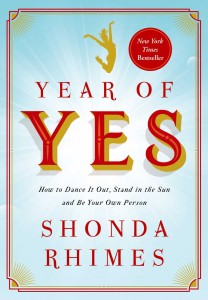 Year of Yes by Shonda Rhimes
Year of Yes by Shonda Rhimes
I’m not usually one for “self help” books – especially celebrity ones. Still, one day, when I turned on NPR, Ms. Rhimes was being interviewed about her new book, Year of Yes. I was suddenly in rapt attention. She was witty, smart-mouthed, exceedingly down-to-earth and wow – a woman of color, and a driving force in the male-dominated world of network television.
Later that day, as a treat after teeth cleaning, I ducked into a favorite bookstore in the Marina and picked up Year Of Yes, certain it wouldn’t be for me, but 20 pages later, laughing out loud in the aisle, I had to buy it.
Shonda Rhimes is the creator and producer of Thursday night network television – Greys Anatomy, Private Practice, Scandal and How to Get Away with Murder. She claims she merely “makes stuff up for living” – which has made her a highly-respected television mogul and a multi-millionaire.
Although I was a fan of Grey’s Anatomy (until Sandra Oh left), I’ve never watched any of her other hit series. But I’ve always admired that all her shows feature characters whom reflect what she calls normalcy – all races, ages, sizes, sexual orientation and backgrounds. Creating and producing these ground breaking dramas we find out took guts, perseverance and some major rule breaking. No gentle “lean-in” for Ms. Rhimes — she kicked down doors, stereotypes, racism, sexism, and a few butts along the way — all in order to get her ground breaking, vibrantly diverse shows on air.
This part self-help – but mostly memoir reveals that as strong as Ms. Rhimes was at work, internally she was a shy introvert, was most comfortable writing alone in mismatched pajamas and wished to remain very far removed from the typical Hollywood hype.
When I first got a publicist, I told him and his team that my main reason for having a publicist was so that I never ever had to do any publicity. Everyone thought this was a joke, I was not joking.
Ms. Rhimes is a highly-educated, hard- working genius, raising three children as a single mom and a sister in a large competitive family – that seemed enough and protected her from having to say yes to things that made her uncomfortable.
Then, one Thanksgiving morning, her older sister angrily mutters that she never says yes to anything — not to social events, publicity, family affairs, or to having fun. This proved to be a turning point for Ms. Rhimes as she realized her excuse of being too busy with three prime-time television shows and raising her daughters on her own — was actually a cop-out. Ms. Rhimes began to discover that her “no’s” were preventing her from fully experiencing her life — trapping her in negativity and isolation.
So begins her scary year of saying yes. Yes to accepting compliments and the help she needs to balance her career with single motherhood and yes, to taking care of herself — which results in a 100+ lb weight loss.
Ms. Rhimes gives herself permission to answer the question “How do yo do it all?” with the honest answer – she doesn’t. She credits and idolizes her live-in nanny, makes no excuses when relying on Costco baked goods for school events (despite the other mothers’ home baked offerings) and gives herself permission to unashamedly practice “badassery”.
One chapter relates her decision to remain single and the hurt she causes the men she’s loved in her life. And to those who ask, she answers that their idea of a happily-ever-after ending is not the same as hers. Again, yes to her life choice(s).
It doesn’t mean she doesn’t say no…
No is a powerful word. To me, it’s the single most powerful word in the English language. Said clearly, strongly and with enough frequency and force, it can alter the course of history.
Her public calendar becomes full. She revels at sitting next to First Lady Michelle Obama at the Kennedy Center Honors – and realizes that, a year ago, she would have turned down this once-in-a-lifetime opportunity.
If you google Shondra Rhimes you can watch her interviews and public appearances with Oprah, Jimmy Kimmel, even a commencement address to her alumni at Dartmouth.
But, I believe her best speech is a short one, when she was awarded the Sherry Lansing Award for leadership. Here Ms. Rhimes credits the many, many women who came before, those who actually broke the glass ceiling so that women in the last 20 years could be successful. Recommended viewing HERE.
Trust me, Year of Yes is not a fluffy celebrity memoir with advice thrown in, Ms. Rhimes doesn’t preach or condescend. She touts a mean work ethic and her message is; you’ve just got to do it — the impossibly difficult, soul-breaking work; you can’t (and won’t) be able to do everything; you will make sacrifices; you’ll make mistakes – but no matter what, you continue to do the hard work.
Year of Yes is a quick read, it’s funny and down-to-earth, but don’t sell it short – within its short pages are the thought-provoking life lessons learned by a woman overcoming her fears, succeeding on her own terms and being comfortable with all of it. She ends the book with this:
I am different. I am original. And like everyone else, I am here to take up space in the universe. I do so with pride.
Falling in love ~~
Marriage requires falling in love many times, always with the same person.
(Mignon McLaughlin)
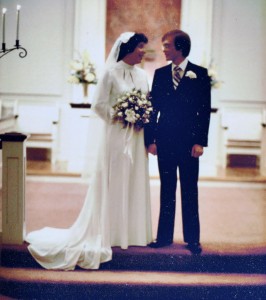
Happy Anniversary to my favorite person – may we keep falling in love for many more years.


